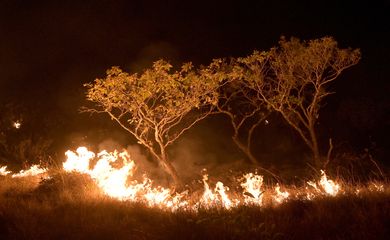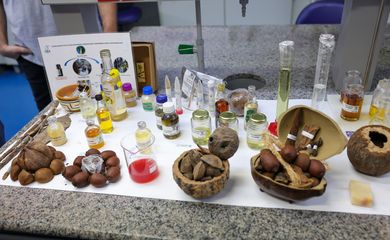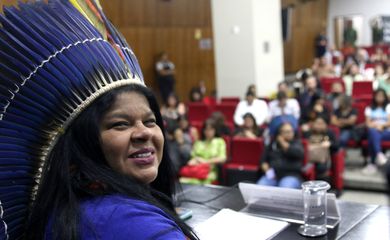State-of-the-art technology helps monitor Amazon air and biodiversity

The song of birds. The ruffling of leaves as the jaguar prowls through the jungle. The communication between pirarucu fish swimming in the river. Deep in the Amazon forest, sounds come together to form an orchestra. Even untrained ears can appreciate the symphony. However, if one of its instruments goes off-key or its music comes to a halt, the dissonance is just as evident.

The analogy between music and biodiversity in the Amazon was drawn by biologist Emiliano Ramalho, 46, who has lived in the forest for over two decades. It is the best way he has found to explain how the continuous monitoring of animals helps assess the dynamics of the ecosystem and stay alert for any red flags.
Ramalho is the technical and scientific director of the Mamirauá Sustainable Development Institute, in the city of Tefé, Amazonas state, an entity linked to Brazil’s Ministry of Science, Technology, and Innovation. Since 2016, he has been at the helm of the Providence Project, which uses automated sound and image systems to study Amazon species. Over 40 sensors are spread throughout the forest, active 24/7.
“Through technology, we get to observe a number of species and behavior types we’d never be able to monitor by natural means. It completely changes the way we look at the fauna. Technology won’t keep us from having to do fieldwork, but it does serve as a kind of seventh sense for us,” he argued.
Emiliano Ramalho kept count of pirarucu populations early in his career and later on became one of the leading experts on jaguars, particularly in floodplain environments. In a landscape under floods for three to four months a year, the feline takes to living in the treetops as a form of adaptation. Ramalho was the first scientist to record this behavior.
“The jaguar plays a key role in the conservation of the forest, and the forest is essential for the survival of the jaguar,” he remarked. Perfected by technological tools, conservation work makes Ramalho confident a better future is still a possibility.
“To work in the Amazon, you need to have hope. I’m optimistic, because both our generation and the next one will still have the chance to reverse this crisis scenario. Today, however, the situation is critical. We don’t really have a buffer zone anymore. So if we don’t revamp the paradigm for forest development, we’re going to lose the Amazon,” he argued.
Digital ecology
Another way of understanding the climate dynamics of the Amazon is examining the vegetation. This has been the path taken by São Paulo scientist Thiago Sanna Freire Silva, a digital ecologist, as he often calls himself, who teaches Environmental Computing at the University of Stirling in Scotland and coordinates projects aimed at monitoring flooded forests.
Silva’s focus lies in understanding how changes in the level of water in times of drought and flooding affect the ecosystem, especially in extreme scenarios. To get a broader analytical view, he scans large swathes of the forest with light detection and ranging (LiDAR) technology—a sensor capable of emitting lasers, mapping, and generating 3D landscapes.
“At first we thought, if we start having really intense droughts all the time, it could be a good thing for the trees, because when they’re flooded they usually stop growing. On the other hand, because of the higher temperatures and the lower rainfall, they may also lack water during the dry season. And the trees will be under stress and even more vulnerable than in solid ground,” he said.
The assessment, he went on, helps scientists identify patterns at macro-structural levels through large scales and understand how the forest operates. Results are enhanced through their connection with micro- and local-level research. To deal with the accelerated pace of the impacts and damage to the ecosystem, adaptations must be considered first, before actual regeneration can be envisioned.
“One of the problems with these major climate crises is that we can’t stop them, given their speed and magnitude. All we can do is adapt, try and better understand what’s happening, and be able to predict how these changes may build up over the decades. That way, we can come up with better strategies for preserving these forests and helping the people who depend on them,” he argued.
By tracking the health of wetlands over a period of years, specialists can detect areas that need to be protected before the damage becomes irreversible. As long as there is research, there is hope.
“Any scientist working with ecology and climate change experiences an emotional rollercoaster. You can become utterly pessimistic sometimes. At other times, you have a burst of optimism. What matters is that we have sought to engage with local communities, the people who have the greatest capacity to protect and make a difference. And sometimes they may not even realize the power they have,” the researcher said.
A forest under stress
In the work of chemist Luciana Gatti, in turn, the signs of deforestation and crisis are detected in the air. She coordinates the Greenhouse Gas Laboratory (LaGEE) at Brazil’s National Institute for Space Research. Since 2003, she has been working on climate change, focusing on the role of the Amazon in carbon emission and absorption.
The measurement of emissions began in 2004, in the Tapajós National Forest, in Pará. Since 2010, efforts have reached other locations in the Amazon. Small planes fly over specific spots in the forest, where air samples are collected and stored in vials for analysis.
This can serve to calculate whether the forest is behaving as a carbon source or a carbon sink. In other words, whether it has maintained its capacity to absorb more greenhouse gases than it is releasing.
“The first observation was that one section of the Amazon is quite different from another. Most scientists adopt a rate and apply it to the entire biome. We saw that the more the forest was cleared, the more the region had lost rainfall and increased in temperature over 40 years. And this happened mainly during the dry season—specifically from August through October. Deforestation isn’t just about carbon loss and greenhouse gas emissions. It’s also a change in climatic conditions in the part of the forest that hasn’t yet been deforested,” Gatti pointed out.
In other words, surrounded by encroaching deforestation, the forest has come under stress.
“We’re killing the forest both directly and indirectly. The tree can’t photosynthesize. It’s so dry underground it’s forced to close its stomach, as it were, to avoid losing water and stay alive. That’s why trees in the most deforested regions emit seven times more carbon than those in less deforested regions,” she added.
Ideally, the rainforest’s carbon balance should be neutral, with emissions and absorption canceling each other out. But with deforestation, the forest itself becomes a source of carbon and loses its ability to regulate the climate. There is no other solution, the scientist warned, than to stop destruction and prioritize forest restoration projects.
“We need a survival plan to restore the lost areas of the Amazon. I have a suggestion. Let’s make it a goal to reduce the Brazilian cattle herd by 44 percent, since it’s where most greenhouse gas emissions come from, and since most deforested areas become pastureland,” she said. “Our survival plan is to plant trees. It lowers the temperature and protects us from heat waves and extreme events. Whoever says destroying the forest brings progress doesn’t know what they’re saying. Saving the Brazilian people requires saving the Amazon. We should all be activists,” the researcher said.
*The reporting team traveled at the invitation of CCR, Brazil’s largest mobility infrastructure company, sponsor of TEDxAmazônia 2024.








